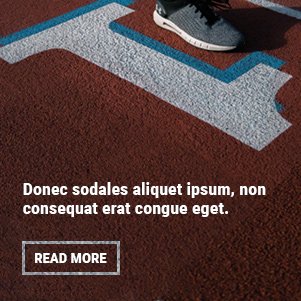Pumping out endless squats is not the only—or best—way to challenge your lower body. That’s why a solid dumbbell leg workout will include exercises that hit all the major compound movement patterns.
“The main thing is, you want a hip hinge, a squatting pattern, a hip bridge pattern, and hip abduction,” ACE-certified personal trainer Sivan Fagan, founder of Strong With Sivan, tells SELF.
Though this might sound complicated, you’re probably actually pretty familiar already with examples of these motions. A hip hinge is a vertical movement where you bend your knees slightly, flex at your hips, and send your butt backward (like in a dumbbell Romanian deadlift or a barbell good morning). A squatting pattern involves flexing at the hips and the knees as you lower your butt downward, as if you were sitting in a chair (like in a goblet squat or a lunge). With a hip bridge, you extend your hips from a horizontal position (like a hip thrust or glute bridge), while with hip abduction, you move your leg laterally away from the middle of your body (like with a side lunge or side-lying leg raise).
By incorporating these functional movement patterns into your leg workout, you’ll end up challenging muscles in the front of your lower body, like your quads, and in the back of your body, like your glutes and hamstrings. You’ll also target the small muscles that make up your side butt—an important area for guarding against injury that’s often overlooked in strength training. Put all of this together, and you’ll get a comprehensive lower-body routine that will help you build balanced strength.
In the leg workout Fagan created for SELF below, getting stronger in all those areas is going to be the name of the game. And in doing so, you may not need to get as sweaty as you might think—slowing down and really honing in on the movements is going to be more important than speed here. Remember, a strength workout doesn’t need to become a cardio session!
“If you’re focusing on speed or doing as many reps as possible in a certain amount of time and only taking a little bit of time to rest between sets, you’re not going to be able to lift as much weight, which is key to building strength,” Fagan says. “A workout that focuses on getting you as sweaty as possible or as fatigued as possible is not equal to an effective workout.”
That’s why in this dumbbell leg workout, you’re going to take the time for ample rest—one to two minutes—between either straight sets (where you take a breather after your reps) or supersets (when you do two exercises back to back). This will give your muscles the recovery they need to be able to complete the same number of reps during your next set. Over time, you’ll likely notice you’re able to lift more weight or do more reps with the same weight. That’s progressive overload, and it’s vital to getting stronger.
WATCH20-Minute Total Arms Workout
ADVERTISEMENT
You should rest long enough during your rest intervals for your heart rate to get back to near-baseline, but that doesn’t mean the workout will feel easy: A lot of these dumbbell leg exercises use compound moves—working multiple muscle groups across more than one joint—and you’ll be sprinkling in some unilateral movement too.
“When you are doing single-leg work properly and not rushing through it, it’s intense,” Fagan says. “It requires balance and core stability.”
Before you get started with this dumbbell leg workout, make sure you fit in a warm-up first—this glute activation circuit is a great choice for waking up the lower-body muscles that are going to be working hard in this routine.
Ready to start your next leg day? Here’s what you need for an at-home dumbbell workout that’ll smoke your lower body.
The Workout
What you need: A pair of dumbbells. (How much weight will depend on your experience and fitness level, but a medium pair—say, 8 to 20 pounds—can be a good jumping off point.)
The Exercises
Straight set
- Single-Leg Deadlift to Reverse Lunge
Superset 1
- Single-Leg Glute Bridge
- Glute Bridge
Superset 2
- 5 O’Clock Lunge
- Side-Lying Leg Raise
Directions
- For the straight set, complete 8–12 reps per side. Rest for 1–2 minutes. Complete 3–4 sets total.
- For superset 1, complete 8–15 reps per side of the single-leg glute bridge and 8–12 reps of glute bridge. Rest for 1–2 minutes. Complete 3–4 rounds total.
- For superset 2, complete 12–15 reps per side of the 5 o’clock lunge and the side-lying leg raise. Rest for 1–2 minutes. Complete 3–4 rounds total.
Demoing the moves are Amanda Wheeler (GIFs 1 and 4), host of the Covering Ground podcast; Gail Barranda Rivas (GIF 2), a certified group fitness instructor, functional strength coach, Pilates and yoga instructor; Heather Boddy (GIF 3), a group fitness instructor and creator of the Geeknasium workout program; and Anise Armario (GIF 5), creator and teacher of The Movement at Dancewave in Brooklyn.
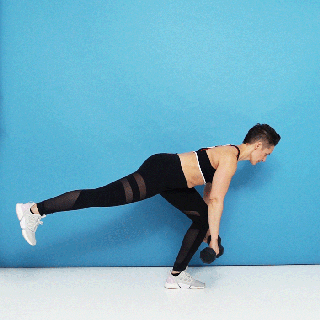 Katie Thompson1Single-Leg Deadlift to Reverse Lunge
Katie Thompson1Single-Leg Deadlift to Reverse Lunge- Stand with your feet together, holding a dumbbell in each hand in front of your legs.
- Shift your weight to your left leg and, while keeping a slight bend in your left knee, raise your right leg straight behind your body, hinging at the hips to bring your torso parallel to the floor, and lower the weight toward the floor. (You may need to bend your knee a bit more depending on your hip mobility and hamstring flexibility.)
- Keep your upper back flat. At the bottom of the movement, your torso and right leg should be almost parallel to the floor, with the weight a few inches off the floor. (If your hamstrings are tight, you may not be able to reach as far down.)
- Keeping your core tight, push through your left heel on your back leg to stand up straight and pull the weight back up to the starting position. Bring your right leg back down to meet your left. Pause there and squeeze your butt.
- Step back (about 2 feet) into a reverse lunge with your right foot, landing on the ball of your right foot and keeping your heel off the floor. Bend your front knee and back knee to create two 90-degree angles with your legs. Your back knee should hit the floor.
- Push through the heel of your left foot to return to standing. That’s 1 rep.
- Complete 8–12 reps, then switch sides.
 Katie Thompson2Single-Leg Glute Bridge
Katie Thompson2Single-Leg Glute Bridge- Lie on the floor face up with your knees bent and feet flat on the floor. With your hands at your sides, your fingertips should come close to grazing your heels. Engage your core to press your lower back against the floor.
- From this position, lift your left foot off the floor and extend your leg.
- Push off your right foot, engage your core, and squeeze your glutes as you lift your hips and do a glute bridge.
- Slowly lower your hips back to the floor. This is 1 rep.
- Complete 8–15 reps on one side, then repeat on the other.
Most Popular
- This Low-Impact Cardio Workout Will Actually Get Your Heart Rate UpBy Amy Marturana Winderl, C.P.T.
- This Chia Pudding Hack Gets You a Fiber-Rich Breakfast in 5 MinutesBy Caroline Tien
- 17 Hot Ways to Stimulate Your Clit for an Amazing OrgasmBy Erica Sloan
ADVERTISEMENT
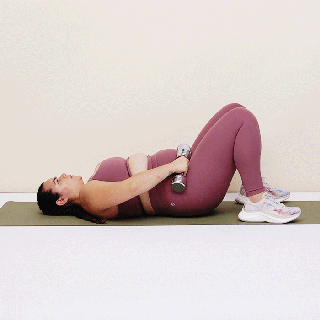 Katie Thompson3Glute Bridge
Katie Thompson3Glute Bridge- Lie on your back with your knees bent and feet flat on the floor, hip-width apart. Hold a dumbbell in each hand and rest them right under your hip bones. This is the starting position.
- Squeeze your glutes and abs and push through your heels to lift your hips a few inches off the floor until your body forms a straight line from your shoulders to your knees.
- Hold for a second and then slowly lower your hips to return to the starting position. This is 1 rep.
- Complete 8–12 reps.
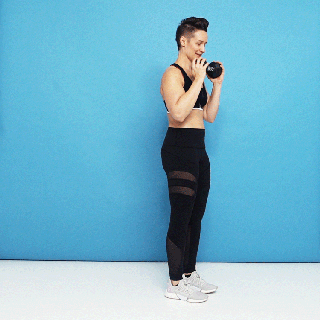 Katie Thompson45 O’Clock Lunge
Katie Thompson45 O’Clock Lunge- Stand with your feet hip-width apart. Hold one dumbbell by both ends in front of your chest with your palms facing in toward each other and your elbows bent. This is the starting position.
- Take a big step to the side with your right foot, rotating away from your body clockwise toward the 5 o’clock position.
- Keeping your left leg straight, left foot flexed, and your chest lifted, bend your right knee and push your butt back to lower into a lateral lunge.
- Push through your right heel to stand, rotating back to the starting position. That’s 1 rep
- Do 12–15 reps on one side, and then repeat on the other side.
Most Popular
- This Low-Impact Cardio Workout Will Actually Get Your Heart Rate UpBy Amy Marturana Winderl, C.P.T.
- This Chia Pudding Hack Gets You a Fiber-Rich Breakfast in 5 MinutesBy Caroline Tien
- 17 Hot Ways to Stimulate Your Clit for an Amazing OrgasmBy Erica Sloan
ADVERTISEMENT
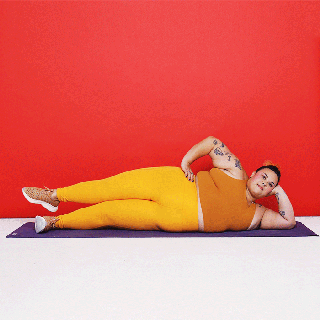 5Side-Lying Leg Raise
5Side-Lying Leg Raise- Lie on your left side, with your legs extended straight. Support your head with your left hand.
- Lift your top leg 45 degrees, then lower slowly. This is 1 rep.
- Complete 12–15 reps, and then repeat on the other side.

